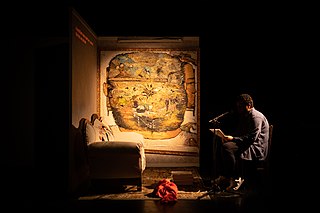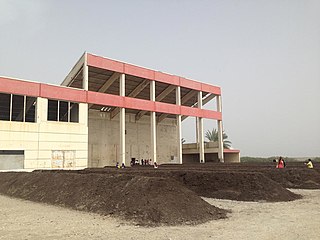
The Emirate of Sharjah is one of the emirates of the United Arab Emirates, which covers 2,590 square kilometres (1,000 sq mi) and has a population of over 1,400,000 (2015). It comprises the capital city of Sharjah, after which it is named, and other minor towns and exclaves such as Kalba', Al Dhaid, Dibba Al-Hisn and Khor Fakkan.
James Lee Byars was an American conceptual artist and performance artist specializing in installations and sculptures, as well as a self-considered mystic. He was best known for his use of personal esoteric motifs, and his creative persona that has been described as 'half dandified trickster and half minimalist seer'.
Rirkrit Tiravanija is a Thai contemporary artist residing in New York City, Berlin, and Chiangmai, Thailand. He was born in Buenos Aires, Argentina in 1961. His installations often take the form of stages or rooms for sharing meals, cooking, reading or playing music; architecture or structures for living and socializing are a core element in his work.

Sharjah is the third-most populous city in the United Arab Emirates, after Dubai and Abu Dhabi. It is the capital of the Emirate of Sharjah and forms part of the Dubai-Sharjah-Ajman metropolitan area.

Geeta Kapur is a noted Indian art critic, art historian and curator based in New Delhi. She was one of the pioneers of critical art writing in India, and who, as Indian Express noted, has "dominated the field of Indian contemporary art theory for three decades now". Her writings include artists' monographs, exhibition catalogues, books, and sets of widely anthologized essays on art, film, and cultural theory.

Ranjani Shettar is a visual artist from Bangalore, India known for her large-scale sculptural installations. Her work has been displayed at The Metropolitan Museum of Art, the Museum of Modern Art (MoMA), the San Francisco Museum of Modern Art (SFMoMA), among others.

Sheikha Bodour bint Sultan Al Qasimi is the Chairperson of the Board of Trustees and President of the American University of Sharjah, Chairperson and President of Sharjah Research, Technology and Innovation Park (SRTIP), Chairperson of the Sharjah Investment and Development Authority, Chairperson of Sharjah Entrepreneurship Center (Sheraa), Founder and Chief Executive Officer of Kalimat Group, Founder and Chairperson of Kalimat Foundation, Chairperson of Sharjah Book Authority, Founder of the Emirates Publishers Association, Founder of the UAE Board on Books for Young People and past President of the International Publishers Association. Her father is His Highness Dr. Sheikh Sultan bin Muhammad Al-Qasimi, who has served as Ruler of the Emirate of Sharjah since 1972.
The Sharjah Biennial is a large-scale contemporary art exhibition that takes place once every two years in the city of Sharjah, United Arab Emirates. The first Sharjah Biennial took place in 1993, and was organized by the Sharjah Department of Culture and Information until it is reorientation in 2003 by Hoor bint Sultan Al Qasimi.

The Sharjah Art Foundation is a contemporary art and cultural foundation based in Sharjah, the United Arab Emirates, founded in 2009 by Hoor Al Qasimi, daughter of Sultan bin Muhammad Al-Qasimi, a member of the Supreme Council of the United Arab Emirates and current ruler of Sharjah, to support artists and artistic practice in the Sharjah communities, the UAE, and the region via different platforms that include Sharjah Biennial, the annual March Meeting, art residencies, production grants, commissions, art exhibitions, artistic research and publications. The foundation include exhibitions featuring the work of Arab and international artists, performances, music, film screenings, artist talks, and educational for a range or audience from children to adults. The Sharjah Art foundation strives to promote public learning and participating in art practices.
Bani Abidi is a Pakistani artist working with video, photography and drawing. She studied visual arts at the National College of Arts in Lahore and at the School of the Art Institute of Chicago. In 2011, she was invited for the DAAD Artists-in-Berlin program, and since then has been residing in Berlin.

Ali Cherri is a Lebanese artist working in video and installation. His varied practice focuses on documenting and presenting heritage and environment in Lebanon and other Middle Eastern countries.
Wael Shawky is an Egyptian artist.

Tabor Robak is an American Contemporary Artist working in New Media, living in Paris, France. Robak is primarily known for his trailblazing digital art practice, multi-channel video installations and generative artworks. Robak's work has been exhibited and collected internationally at renowned institutions such as Museum of Modern Art, Serpentine, National Gallery of Victoria, Albright Knox, and Migros Museum. In 2014, Robak was named in Forbes’ 30 under 30 in Art. Robak has guest lectured MFA students at Yale and co-taught an MFA course on real time 3D at New York University.
Adrián Villar Rojas is an Argentinian sculptor known for his elaborate fantastical works which explore notions of the Anthropocene and the end of the world. In his dream like installations he uses aspects of drawing, sculpture, video and music to create immersive situations in which the spectator is confronted with ideas and images of their imminent extinction.
Random International is a London-based art collective and collaborative studio, founded in 2005. The group shot to prominence with its interactive Rain Room art installation. Its work includes sculpture, performance and large-scale architectural installations. Two of its exhibition pieces have now become permanent installations, the first of which was the critically acclaimed and popular Rain Room, now permanently housed in Sharjah, United Arab Emirates (UAE).
Budiardjo 'Budi' Tek was a Chinese-Indonesian entrepreneur, philanthropist and art collector, and the founder of the Yuz Foundation. Following a successful business career, Tek started collecting art works in 2004, amassing a collection of over 1,500 pieces, including a number of difficult to display 'mega art' works, he announced he would turn the collection into a non-profit public institution in 2017 following a 2015 diagnosis of pancreatic cancer. In 2018 he announced that he would partner with the Los Angeles County Museum of Art (LACMA) to form a foundation that would house most of his collection of Chinese contemporary art.

The Yuz Museum Shanghai is a non-profit organization under the umbrella of the Yuz Foundation. It is located in the West Bund in Xuhui District, Shanghai. Yuz is reconstructed from the hangar of the original Longhua Airport and designed by Japanese architect Sou Fujimoto.

Kader Attia is an Algerian-French artist.

Ali Eyal, Is an Iraqi visual artist and he's currently based in Los Angeles who works internationally. His work explores the complex relationships between personal history, transitory memories, politics & identity using different media, primarily based in the medium of painting, and further transformed through other media - such as installations art, photography, text and video.

Kalba Ice Factory is a gallery and art space in Kalba, Sharjah, a city on the East Coast of the United Arab Emirates. The 20,000 square-metre building was constructed by renovating a derelict feed mill and ice factory. It was opened to the public on the 8 February 2023, the opening timed to house Sharjah Biennial 15.












